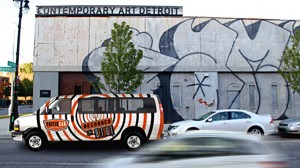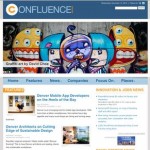
How Many Websites Now Cover the Arts in Colorado?
Last September, I was invited as guest art critic to give an update on the status of art criticism in the digital age to the Art Student’s League of Denver. (Fellow panelists were Denver dealer Ivar Zeile and artist/blogger Theresa Anderson.) In the past seven years more than half of all arts journalism jobs have been eliminated in American newsrooms and according to Pew Research Center, all newsroom jobs have declined by 30% since 2000. I wanted to, in digital-media style, ask the audience an important question: Did they read (need?) criticism? Was it important to them?
Is criticism an adjunct marketing tool to promote the business of art? Or worse, are art editors and critics simply a courtier class as Dave Hickey suggested to The Guardian? Or is criticism and arts journalism merely dictated by the financial news as Sarah Thornton laments.
On the fringes of the contemporary art world in places like Denver, the questions and concerns about art criticism are different. “What are we going to do in Denver?” “How do we get coverage?”
Denver lost the Rocky Mountain News (the West’s oldest paper folded in 2009) and then The Denver Post (through buyouts and newsroom cuts, lost critics Kyle Macmillan and John Moore, arts editor Ray Rinaldi does it all now).
Does Criticism Matter?

Is criticism about coverage, cash, being a courtier, or discourse?
Most newspaper critics, when asked, claim their job is to educate readers about art. (New York Times chief art critic Roberta Smith told a Santa Fe audience attending an NCECA conference, in 2010, that only 26 jobs like hers existed in the US.)
Perhaps this education approach is one of the reasons the basic agreement of digital life is that readers get to co-curate their news. They don’t want one-way lectures, which immediately seem to be elitist, boring, a turn off. They want a more democratic and pluralistic approach–a dialogue.
However, what we have ended up with, in the absence of independent critics, is a bubble, where online we often choose to curate and read only those who agree with our positions. We associate with those who are on the same path as we are. Curators and museums network around the business of art reputations and auction sales, wanting to control their message –they rarely invite critics to the table.
“The market seems to have declared that arts criticism as a profession, as a calling, isn’t supportable, isn’t sustainable, isn’t legitimate,” Douglas McLennan wrote in 2011 on his blog Diacritical when John Terauds, classical music critic of the Toronto Star was reassigned to the paper’s business section. “We could go on about what was lacking or what didn’t work in the way we covered the arts. But the cold hard truth is that there just isn’t an audience for what we were doing.”
McLennan is the founder and editor of ArtsJournal (a daily online arts news aggregator that he established in 1999) and he teaches at the NEA Arts Journalism Institutes and the USC Annenberg School For Communication and Journalism that ran the online arts newrooms projects, Engine 28 and Engine 29. During the Engine 29 experiment in 2012 the fellows determined that “the trickle-down theory didn’t work in economics and it doesn’t work in arts journalism. People who aren’t already encountering your work generally won’t, which means if you want to reach new communities, you have to build the pipelines.”
They went on to add that the problem lay in construing writing for a broader audience, by mastering new media and realizing that criticism happens everyday on social media; as well as “thinking beyond” the arts section, being entrepreneurial and being more broadly representative of artists.
New Models, New Money
To that end, the  CriticCar in Detroit. CriticCar is a mobile recording system proposed by two New York journalists, Jennifer Conlin and Dan Shaw, offering event-goers the opportunity to record video reviews as they exit a performance or exhibition. Akron, Macon, Miami, San Jose and St. Paul also received $20,000 each to create action plans for their proposed models for arts journalism. All in an effort to find a reciprocal model that can be shared from city to city to resurrect art criticism from its grave. But the question remains: Is any of this really criticism and will a one-size-fits-all model help find an audience for criticism?
CriticCar in Detroit. CriticCar is a mobile recording system proposed by two New York journalists, Jennifer Conlin and Dan Shaw, offering event-goers the opportunity to record video reviews as they exit a performance or exhibition. Akron, Macon, Miami, San Jose and St. Paul also received $20,000 each to create action plans for their proposed models for arts journalism. All in an effort to find a reciprocal model that can be shared from city to city to resurrect art criticism from its grave. But the question remains: Is any of this really criticism and will a one-size-fits-all model help find an audience for criticism?
Another problem is that nothing is yet sustainable as a business model. Digital ad revenue remains a mere 10% of ad and circulation revenue for publications like The Denver Post. Technorati counts some 300,000 art blogs online with the best of them focused on art centers—New York, LA, San Francisco, Chicago, Houston, Santa Fe and nary a mention or glimpse at Denver except for this online magazine, AdobeAirstream.com (entering year five on March 15), highlighted by McLennan during the 2009 National Summit on Arts Journalism. At that “contest,” Glasstire, FLYP Media (now defunct), and San Francisco Classical Voice all were awarded prizes from $4,500 to $9,500. FLYP Media shut down in early 2010 when the investor pulled out.
In Denver it appears a form of xenophobia applies. Many readers don’t read my work in AdobeAirstream, believing that since this site is regional and not solely Colorado-centric, it can’t pertain. Or because it’s not New York-based, it’s irrelevant. In the meantime, as new media pipelines appear to offer some hope for arts journalism, they tend to come from invested power brokers in the Chambers of Commerce arena: municipal, financial powers that really know nothing about creating media, much less criticism, except as an adjunct to tourism messages. For criticism to work, boosterism motivations have to take a back seat to independent dialogue.
New Art Media in Colorado
In the past year we’ve seen the launch of multiple art and culture related websites based in Denver, all of which are seemingly unaware of the larger dialogue and experimentation happening in the arts journalism sphere:

Confluence-Denver (funded by big dollar backers to attract the “creative class” to Denver, a subject on which AdobeAirstream has written extensively)
 Culturewest (an effort by John Moore to turn his ranking as one of the best theater critics in the country into a viable endeavor);
Culturewest (an effort by John Moore to turn his ranking as one of the best theater critics in the country into a viable endeavor);
Colorado Art Seen (a website and print publication attempting to cover all of the arts across Colorado with content created by artists for artists);
The Scen3 (the website of the Tier Three Scientific and Cultural Facilities Districts that wants to publish reviews to attract audience to their venues):
 The Invisible Museum (the digital version of the defunct print publication Eye Level, featuring some better writing and contributions by volunteer bloggers and critics) and;
The Invisible Museum (the digital version of the defunct print publication Eye Level, featuring some better writing and contributions by volunteer bloggers and critics) and;
 ColoradoCreates.com (Disclosure: I edit and “curate” this website for Colorado Creative Industries, a division of the Office of Economic Development and International Trade, to promote seven categories of Colorado “creative” industry: Culinary, Design, Film & Media, Heritage, Performing, Publishing and Visual).
ColoradoCreates.com (Disclosure: I edit and “curate” this website for Colorado Creative Industries, a division of the Office of Economic Development and International Trade, to promote seven categories of Colorado “creative” industry: Culinary, Design, Film & Media, Heritage, Performing, Publishing and Visual).
More recently comes the news that Bonfils-Stanton Foundation has given nearly $1 million to Colorado Public Radio to hire an arts editor and two arts journalists to create an arts bureau which they describe as an “online hub intended to become a one-stop, multimedia destination for arts news, information and performances in Colorado.”
Freelance reviewers are also expected to contribute.
Public Radio and the Arts
Studio 360 is probably the most successful of public radio’s experiments in arts journalism. The Peabody Award-winning Studio 360 with host Kurt Anderson is produced by PRI and WNYC and is a guide to pop culture and the arts. In Minneapolis, Art Hounds features three people from the Minnesota arts community talking about a performance, opening or event—insiders sharing their insider information on the art scene. And in other local markets, there are other small efforts to cover arts on public radio.
What remains to be seen is if Colorado Public Radio is structuring its model on either Studio 360 or Art Hounds, or if it is inventing a new model.
Returning to Art Criticism
Is the premise upon which art criticism is based–that art needs criticism to help it connect to the larger world–a fallacy?
David Levi Strauss who is chair of the Art Criticism and Writing MFA Program at the School of Visual Arts says: “If you want to engage, if you want discourse, you need criticism.”
Then how do we innovate criticism in this century and beyond? According to Michael Raynor, author of The Innovator’s Manifesto innovation is especially powerful when it is disruptive. It is time to disrupt the status quo where art criticism is concerned.
Raynor presents in his book that true disruptors define a new frontier and have an enabling technology, which drives the disruption or strategic innovation.
Is criticism sustaining? No.
Is it autonomous or incumbent? It is currently incumbent to the art market, to artists, to current media distribution channels.
Could it be autonomous? We see this in the plethora of blogs and new media publications out there attempting to be self-governed. But producing a website that looks like a print magazine with art criticism that is similar to what one might write in a newspaper is not a new productivity frontier. Hence, the failure of criticism to be innovative. (I acknowledge my own guilt.)
What if critics (and others in the art world) made an effort to engage outside of our bubble? Art is happening in multiple places, not just the so-called cultural centers, and is influenced by multiple histories woven together.What if we focused less on art theory, art history and art centers? What if our language was understandable and less esoteric? What would it look like? And would anyone want to read it?
